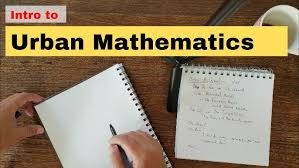Mathematics for Planners
Introduction

Mathematics for Planners is a key course designed to provide urban and regional planners with essential quantitative skills for effective decision-making and problem-solving. This field involves analyzing complex datasets, forecasting future trends, and optimizing resources to develop sustainable and functional urban environments. Mathematics offers the necessary tools and methods to perform these tasks accurately.
Planners employ a range of mathematical techniques, including statistics, calculus, linear algebra, and probability, to analyze spatial patterns, model urban growth, and assess the impact of various planning decisions. With the advancement of computational tools and geographic information systems (GIS), mathematical literacy has become increasingly important. These tools use mathematical algorithms to process and visualize spatial data, helping planners make informed decisions based on solid evidence.
Mathematics also plays a crucial role in economic analysis, traffic modeling, environmental impact assessment, and demographic studies, all of which are essential to the planning process. As urban areas expand and face complex challenges, applying mathematical principles effectively is vital for planners to design cities that are resilient, efficient, and inclusive.
Key Mathematical Concepts for Planners
Statistics and Probability
- Descriptive Statistics: Summarizing data through measures such as mean, median, mode, variance, and standard deviation.
- Inferential Statistics: Making predictions or inferences about a population based on sample data.
- Probability: Assessing the likelihood of various outcomes, which is crucial for risk analysis and decision-making.
Calculus
- Differential Calculus: Understanding rates of change, which is useful for modeling growth patterns and analyzing trends.
- Integral Calculus: Calculating areas and volumes, important for land use planning and resource allocation.
Linear Algebra
- Matrices and Determinants: Managing large datasets and performing complex calculations, especially in spatial analysis and GIS.
- Vector Spaces: Analyzing multidimensional data, crucial for urban modeling and simulations.
- Optimization Techniques
- Linear Programming: Solving problems related to resource allocation, transportation planning, and land use optimization.
- Non-linear Programming: Addressing more complex scenarios where relationships between variables are not linear.
Demographic Analysis
- Population Projections: Using mathematical models to predict future population growth and its implications for urban planning.
- Age-gender Pyramids: Visualizing and analyzing the age and gender distribution within a population.
Applications in Urban and Regional Planning
- Traffic Modeling and Transportation Planning
- Traffic Flow Models: Using mathematical equations to simulate and analyze traffic patterns, helping to design efficient transportation networks.
- Public Transit Optimization: Applying optimization techniques to improve transit routes and schedules.
- 2. Economic Analysis
- Cost-Benefit Analysis: Using mathematical calculations to compare the costs and benefits of different planning projects.
- Economic Impact Studies: Assessing the economic effects of development projects and policies.
- 3. Environmental Impact Assessment
- Pollution Modeling: Using differential equations to model the dispersion of pollutants in the environment.
- Sustainability Metrics: Quantifying environmental sustainability through indicators such as carbon footprint and resource consumption.
- 4. Spatial Analysis and Geographic Information Systems (GIS)
- Spatial Statistics: Analyzing spatial data to identify patterns, trends, and correlations.
- Network Analysis: Using graph theory to study and optimize urban networks, such as roads and utilities.
- 5. Urban Growth and Land Use Modeling
- Cellular Automata: Simulating urban growth patterns using mathematical rules.
- Agent-Based Models: Representing individual behaviors and interactions to understand their impact on urban dynamics.
Contemporary Challenges and Innovations
- Big Data and Analytics
- Data Mining: Extracting useful information from large datasets to inform planning decisions.
- Machine Learning: Applying algorithms that learn from data to predict urban trends and optimize planning interventions.
- 2. Smart Cities
- Internet of Things (IoT): Integrating mathematical models with IoT data to enhance urban management and services.
- Predictive Analytics: Using historical data and mathematical models to forecast future urban scenarios.
- 3. Climate Change and Resilience Planning
- Climate Models: Using mathematical simulations to predict the impacts of climate change on urban areas.
- Resilience Metrics: Developing and applying mathematical indicators to assess and enhance urban resilience.
Conclusion
Mathematics for Planners is an essential course that provides the quantitative foundation necessary for effective urban and regional planning. By mastering key mathematical concepts and techniques, planners can analyze complex data, model urban phenomena, and make informed decisions that promote sustainable and resilient urban development. As cities continue to evolve and face new challenges, the application of mathematics in planning will remain crucial in shaping the future of urban environments.



